How to treat tennis elbow at home
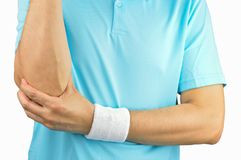
If you have had tennis elbow for a while you will likely understand that a lot of treatment is ineffective and can even make the condition worse, and because of this tennis elbow can become a severe long standing problem. As we will discuss, the problem is that these treatments ignore the major cause of stress on your elbow, so it cannot heal. When this issue is taken care of properly tennis elbow is actually a quite easy problem to treat at home, with excellent success.
In this article we will show you:
- the issue most medical treatments overlook,
- how to tell if you have this issue, then
- the step by step management you can easily do at home.
CONTENTS
What is tennis elbow
Why medical treatment usually does not work
Basic home treatment and management of tennis elbow
Professionals
References
What is tennis elbow
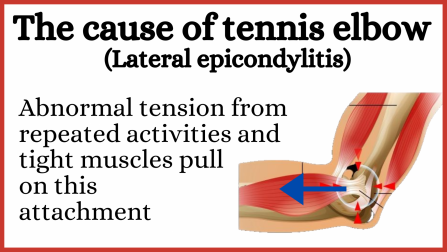
As this diagram shows, abnormal tension on the muscles in your forearm (blue arrow) causes stress where they attach at the outside of your elbow. Over time this can cause the attachment to become inflamed. There are two causes of this abnormal tension.
Intermittent tension
The intermittent tension is caused by repeated use. Every medical text book mentions this. That is why tennis elbow is known as an overuse injury.
Constant tension (the one doctors miss)
The constant tension caused by the muscles being abnormally tight (1-3). The most common reason for them being tight is that they contain (myofascial) trigger points, which are parts of the muscle that have spasmed causing a lump. We will discuss these later.
Why medical treatment usually does not work
There are three main reasons why the results from medical treament of tennis elbow are too often very poor.
- Doctors neglect the constant tension
- Medical treatment targets the effect and ignores the cause
- The exercises given can be counter-productive
Doctors neglect the constant tension
Medical journals tend to just mention the intermittent tension and ignore the constant tension (4,5). Because of this doctors prescribe rest, thinking they are removing the stress allowing the elbow to heal. However, with the constant tension stressing the elbow it cannot heal.
Medical treatment targets the effect and ignore the cause
When the elbow fails to heal therapies such as drugs, needles, laser, and massage are directed at the sore elbow, while all along the abnormal tension is preventing it from healing (6-11).
The exercise given can be counter productive
Doctors and therapists will often prescribe exercises or stretches. While these can relax the muscles sometimes giving temporary relief:
- these exercises pull on the attachment causing further stress
- the trigger points are a spasm or cramp of part of the muscle, so these will soon re-tighten the muscle.
Effective home treatment for tennis elbow
Simply speaking, the home treatment we will share will remove both the intermittent and constant tension, allowing your elbow to heal. If done early the elbow will easily heal itself. If the condition is worse we will advise some simple things to help settle it down. In this section:
How to tell if you have tennis elbow
Lets look at how tennis elbow is diagnosed. The tests are something simple you can do yourself, but please discuss them with a professional.
Symptoms of tennis elbow
The symptoms of tennis elbow are pain at the outside of your elbow, aggravated by activities such as bending back your wrist or fingers, or by gripping.
Simple tests for tennis elbow
There are two basic ways a doctor will test for tennis elbow. With a bit of advice you can easily do these yourself.
- examining your elbow for tenderness
- provocation tests that stress the attachment to see if they cause pain
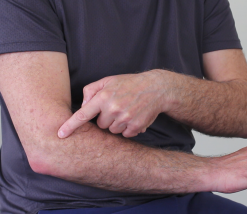
Examining for tenderness
Examine the outside of your elbow. It will be very tender at the bony bump (lateral epicondyle) and for 1-2 cm towards your wrist (the tendon).
Provocation tests
There are a couple of tests with the impressive sounding names Mills and Cozens tests, but these are basically I) bending your wrist forward to tighten the muscles at the back of your forearm that attach to the lateral epicondyle, and ii) bending the wrist back the other way against resistance. These pull on the area injured in tennis elbow, so if they cause pain it is considered positive. Please see these demonstrated in the video below.
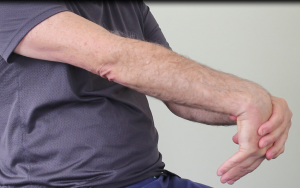
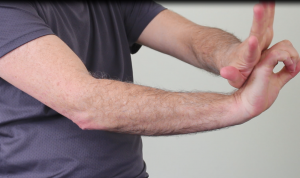
Are trigger points and muscle tightness placing tension on your elbow
The next step is to see if you have trigger points in your forearm muscles creating tension and preventing your tennis elbow from healing. The simple steps are:
- examine your muscles for trigger points
- see if treating the trigger points relieves the elbow
Examine your muscles for trigger points
This can be done using the technique demonstrated the video below. If you find trigger points they will certainly be causing the muscles to be tight, so they will be involved. If pressing on them causes your elbow pain it also shows that they are also causing elbow pain by referral.
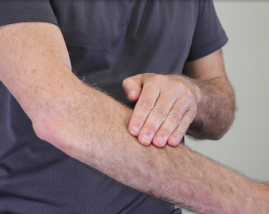
See if treating the trigger points relieves the elbow
This is a very simple procedure. All you do is perform the basic tennis elbow examination and tests. You then the treat the trigger points and re-perform the tests. The trigger point treatment (temporarily) relaxes the muscle. If the muscles were abnormally tight this will relieve tension on the elbow, so there will be less tenderness and less pain.The steps are:
- do the tennis elbow tests,
- treat the trigger points, then
- repeat the tests.
Step one:
Try gripping something or bending your wrist back to reproduce the pain, then examine the outside of your elbow for tenderness.
Step two:
Temporarily relieve the tension in your forearm muscles by treating the trigger points using either of the two methods shown in the video below.
Step three:
Re-test your elbow by doing the activity that previously caused pain and by examining the side of your elbow. If the activity is less painful or the tenderness at the side of your elbow is reduced it is a sign that tension due to trigger points is contributing to you tennis elbow.
Basic home treatment and management of tennis elbow
In this section I’ll go over a basic step by step conservative plan that should fix most tennis elbow problems.
- Step one: settling the tennis elbow down
- Step two: the healing stage
- step three: rehabilitation
- issues that may stop your elbow healing
- prevention
Step one: settling the tennis elbow down
Tennis elbows are often continually sore, with sharp pain upon movements. If this is so the first step is to settle it down so it stops hurting so much and can start to heal.
Modifying activities
While your tennis elbow is settling down you will need to reduce or modify all activities that aggravate the injury. These activities will be very obvious. They will be the ones that hurt.
Reducing the tension in the forearm muscles
At this stage you can start reducing the tension on the injury by treating the tightness and trigger points in the muscles of your forearm. We show you techniques you can use in the video below. It is most important that you only treat the muscles, not the injury. All massage techniques should stop at least 2cm from the painful bump at the side of your elbow.
Braces
If you can avoid using one that’s great, but sometimes braces can be used to reduce the tension of the muscles on the injury.
Stop hurting the injury
A lot of common tennis elbow treatments actually aggravate the injury. These include massage to the elbow, needles, stretches and exercises. Stop these and let the injury settle.
Pain relief
Sometimes anti-inflammatory drugs are used to help reduce pain and swelling. However, these can have dire side effects (12-16). They also artificially block the pain making you think the injury is better than it is, causing you to overdo it and cause more damage. The safest way to help reduce pain and swelling is by applying an ice pack 5 minutes per hour for 48 hours.
Step two: the healing stage
After settling down your elbow may still be a bit sore, but should be relatively pain free except where movements stress the injury. During this phase you continue to minimise stress on the injury while allowing it to heal.
Treatment of forearm muscles
Continue to apply therapy to your forearm muscles. As discusses in our article Why do trigger points keep coming back , problems such as trigger points in your forearm muscles will take a large number of applications of therapy to completely remedy.
Gradually re-introduce activities
It is important to re-introduce activities to get your muscles and joints working normally again. Allow your body to tell you what you can and cannot do. If an activity causes pain the part that it stressed will not have healed yet.
Step three: The rehabilitation phase
If you have had your problem for some time tissues may have shortened and you may have lost strength in some muscles. If this is so, as healing is completed and activities become pain free it is time to start introducing stretching and strengthening exercises.
Special note on stretches and exercises.
We often see stretches and exercises recommended to relieve tennis elbow. These may give short term relief, but stress the injury to it’s long term detriment. Leave the stretches and exercise to the rehabilitation phase when the injury has healed. You will be much safer and better off.
Issues stopping your elbow from healing
When tennis elbow don’t heal issues like scar tissue and adhesions are blamed, but in the overwhelming number of case the tightened forearm muscles are the problem. However, if you have has tennis elbow for a long time or have had a lot ot treatment directed at your ebow like needles or rubbing issues like scar tissue and adhesions can actually a problem. In this case the conservative care I have recommended will take stress of the injury and help a lot, but you may need some professional help to deal with this issue as well.
The main thing is that you will still need to deal with the basic issues like tightened forearm muscles. Forgetting theses issues and focusing on the injured elbow is what usually causes the problem in the first place.
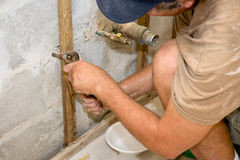
Prevention
Of course the easiest way to treat tennis elbow is to avoid it in the first place. Over time repetitive use of your forearm muscles will cause them to tighten and develop trigger points, causing abnormal tension on the attachment point to the outside of your elbow. If your sport or occupation involves repeated use of your forearms we recommend that you use the techniques described in the appendix to take care of your forearm muscles and avoid problems altogether.
Demonstration of tennis elbow examination and techniques
Professionals
DrGraeme massagers were originally built by Dr Graeme for use in his clinic, and to prescribe to his patients for additional self use at home. Now these are used by colleagues and other professionals for similar purposes. If you are a professional and wish to know more about this therapy, or possibly get a sample massager to trial please check out our practitioner page.
References
. Fernández-Carnero J, Fernández-De-Las-Peñas C, De La Llave-Rincón AI, Ge HY, Arendt-Nielsen L, Johnson GW, et al. Prevalence of and referred pain from myofascial trigger points in the forearm muscles in patients with lateral epicondylalgia. Clin J Pain . 2007;23(4):353–60.
2. Aggarwal A, Daniel J, Palekar TJ. Prevalence of Myofascial Trigger Points in Brachioradialis, Biceps Brachii, Triceps Brachii, Supinator and Extensor Carpi Radialis Brevis in Lateral Epicondylitis. Indian J Physiother Occup Ther - An Int J. 2020;(1):14–8.
3. Fernández-Carnero J, Fernández-De-Las-Peñas C, De La Llave-Rincón AI, Ge HY, Arendt-Nielsen L. Bilateral myofascial trigger points in the forearm muscles in patients with chronic unilateral lateral epicondylalgia: A blinded, controlled study. Clin J Pain. 2008;
4. Smidt N, Windt DAWM Van Der, Assendelft WJJ, Devillé WLJM, Bos IBCK. Corticosteroid injections , physiotherapy , or a wait-and-see policy for lateral epicondylitis : a randomised controlled trial. Lancet. 2002;359:657–62.
5. Johnson GW, Cadwallader K, Scheffel SB, Epperly TEDD. Treatment of Lateral Epicondylitis. Am Fam Physician. 2007;(76):843–50.
6. kotteeswaran k. EFFECT OF MYOFASCIAL TRIGGER POINT RELEASE THERAPY AND ACTIVE STRETCHING ON PAIN AMONG LATERAL EPICONDYLITIS PARTICIPANTS. Int J Res Anal Rev. 2019;6(2):184–8.
7. Lin MT, Chou LW, Chen HS, Kao MJ. Percutaneous soft tissue release for treating chronic recurrent myofascial pain associated with lateral epicondylitis: 6 case studies. Evidence-based Complement Altern Med. 2012;2012.
8. Trivedi P, Sathiyavani D, Nambi G, Khuman R, Shah K, Bhatt P. Comparison of active release technique and myofascial release technique on pain, grip strength & functional performance in patients with chronic lateral epicondylitis. Int J Physiother Res. 2014;2(3):488–94.
9. Khuman R. Myofascial release technique in chronic lateral epicondylitis: a randomised controlled study. Int J Heal Sci Res. 2013;3(7):45–52.
10. Ajimsha M. Effectiveness of myofasial release for lateral epicondylitis in computer professionals. Arch Phys Med Rehabil. 2012;93(4):604–9.
11. Trudel D. Rehabilitation for patients with lateral epicondylitis : a systematic review. J hand Ther. 2019;17(2):1–3.
12. Fine M. Quantifying the impact of NSAID-associated adverse events. Am J Manag Care. 2013;19(14 SUPPL.):267–72.
13. Blower AL, Brooks A, Fenn GC, Hill A, Pearce MY, Morant S, et al. Emergency admissions for upper gastrointestinal disease and their relation to NSAID use. Aliment Pharmacol Ther. 1997;11(2):283–91.
14. Cryer B. NSAID-associated deaths: The rise and fall of NSAID-associated GI mortality. Am J Gastroenterol. 2005;100(8):1694–5.
15. Sostres C, Gargallo CJ, Arroyo MT, Lanas A. Adverse effects of non-steroidal anti-inflammatory drugs (NSAIDs, aspirin and coxibs) on upper gastrointestinal tract. Best Pract Res Clin Gastroenterol. 2010;24(2):121–32.
16. Patrignani P et. al. Managing the adverse effects of nonsteroidal anti-infalmmatory drugs. Expert Rev Clin Pharmacol. 2011;4(5):605–21.
We are continually adding more information on research and uses. Subscribe below to have us email them to you "hot off the press".

About Dr Graeme
Several years ago Dr Graeme, a Chiropractor practicing in Victoria, Australia was looking for a serious hand held massager his patients could use at home to get the extra quality massage they needed. The ones he found in the shops and on-line for home use looked nice but were not serious, and... read more

